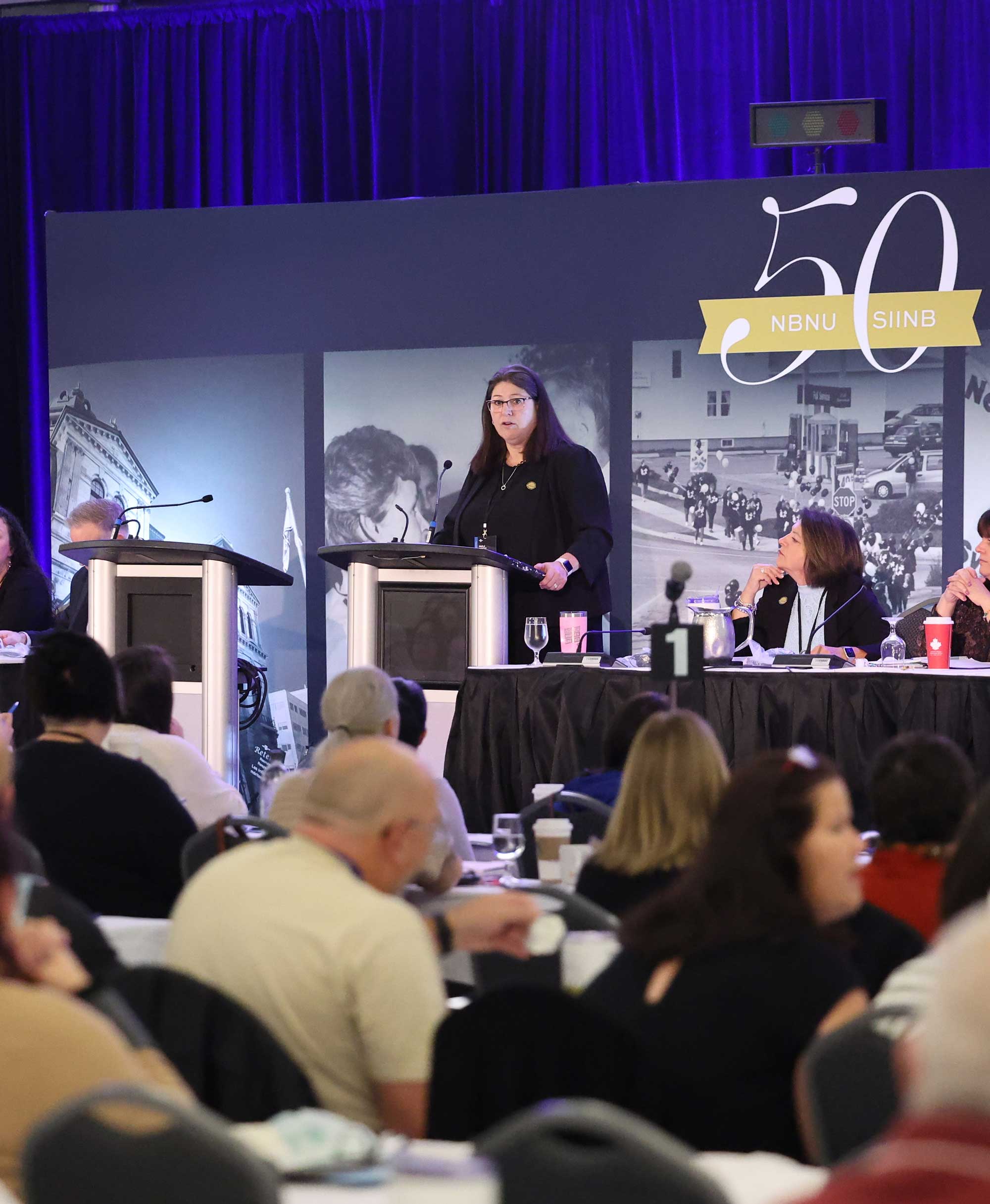When conducting business meetings, such as the annual meeting, NBNU follows Robert’s Rules of Order Newly Revised.
The following is an introduction to Robert’s Rules. This article contains excerpts from A Guide to Parliamentary Procedure Based on Robert’s Rules of Order Newly Revised.
An assembly generally uses five steps to conduct its business:
1. Motion Made
A proposal that the assembly takes certain action or expresses itself as holding certain views is a motion. Verbally, a member introduces a motion by obtaining the floor stating, “I move that …” or she/he may move for the adoption of a written resolution.
2. Motion Seconded
Next, another member who supports the proposal says, “I second the motion.” Requiring a “second” prevents consuming time on a view held by only one member. If there is no second the matter is dropped.
3. Chair States Question
Once a motion is seconded, and considered to be in order, the chairperson states the question to the assembly, clarifying any vague points. Having been restated by the chairperson, the proposal is pending. This means it is before the assembly for consideration and action. (Until a motion is pending, any member may suggest modifications, or the mover may modify or withdraw the motion.) When the chairperson states the question, this opens the floor for debate on the proposal.
4. Debate
That question most recently stated by the chairperson is the one to be acted upon first. Debate (which is discussion of a proposal) is limited to the immediately pending question, and usually each member is limited to two speeches during any debate.
Prior to debating or making a motion, a member must obtain the floor. After previous the speaker yields the floor (usually by sitting down), the member wishing to speak rises and addresses the chair. The would-be-speaker is “recognized” (assigned the floor) by the chair or ruled “out-of-order” in favour of another speaker. In many cases the first one to rise is assigned the floor. A member attempting to “take the floor” for a second speech on the same question is out of order, when any member who has not spoken on that question desires the floor.
a) Amendments to the Motion
An amendment is offered when a member agrees substantially with the motion but wants some change. An amendment must be closely related, although it may be inconsistent, to the subject of the motion. It must be stated clearly and defined as to what part of the motion it applies. An amendment that is not relevant to the main motion is out of order.
To amend a motion, a member must seek and be recognized by the chairperson. Once recognized she/he states: “I move to amend the motion by ….” If another member seconds the amendment, the chair asks if there is any discussion of the amendment.
b) Amending the Amendment
An amendment may be changed just as a motion may be changed. The amendment to the amendment must relate to the motion and the amendment. The chair can sometimes ask the maker of the motion and the seconder if they are willing to accept the amendment as part of the original motion. If they agree and if no other member objects, this can be done, saving time and effort. The chair must carry though each step until the main motion has been voted on. There can be no amendment to an amendment to an amendment. If it gets to that point, a substitute motion is in order. Voting is done in reverse order, that is, on the amendment to the amendment, then the amendment, then the motion as amended.
c) Substitute Motion
A substitute motion ties together loose ends. It may be made and accepted by the chairperson. Amendments or substitute motions cannot be accepted if they are not relevant to the motion.
d) Tabling a Motion
The membership may seem unable to reach a conclusion or more study may be needed. At these times, a member makes a motion to “table a motion.” The maker of the motion cannot do so while speaking on the motion, or if she/he has previously spoken on the motion and there are others who still desire to speak, such a motion requires a second, and once seconded, cannot be debated or amended. It must be put to an immediate vote. If a majority votes in favour, the motion is then tabled. “Tabling” a motion does not carry a time limit. A motion to table until the next meeting is a motion to postpone and is debatable. If a member wants to postpone indefinitely, or if a member wants to place the matter in the hands of a committee, the motion should be stated in these terms: “I move that the matter be referred back to the education committee.”
e) Points of Information
Members sometimes become confused about the business being discussed. They may need some information from the chairperson or the speaker about the meaning of the motion or its effect. If so, they may direct an inquiry to the chairperson. Members do not have to wait to be recognized by the chairperson, but may interrupt by stating: “I rise on a point of information.” The chairperson must recognize the member and say, “state your question.” The chairperson then seeks to answer the question or if the member desires information from another member, the chairperson should ask the person holding the floor to yield for the purpose of getting the information. The person holding the floor cannot be forced to yield, but if she/he does, the questioner must address the point of information through the chairperson and the answer must be made to the chairperson. If the chairperson decides that the question does not require an immediate answer, the inquiry can be answered as soon as the speaker is finished.
5. Vote
Once debate is over, the chairperson asks again, “Are you ready for the question?” If no one goes to the mic to speak, the chairperson restates the question and takes the vote. This is usually done by a show of hands. If the result is unclear, the chair may ask for a standing vote.
For a motion to pass, it will require either a majority (50% plus one) or 2/3 of the members present and voting on that motion. Therefore, if x numbers of members are registered for the day and then some members leave, the vote is determined by the majority or 2/3 (depending on what is required) of the remaining members who vote.
Note: All motions, discussions and debate of motions must take place through the chairperson. Members are not allowed to debate issues among themselves.
Quorum is the number of registered members that are entitled to vote who must be present in order to legally transact the meeting’s business.
NBNU’s by-law 11.07 states: Three-quarters (3/4) of the voting delegates accredited to the meeting shall constitute a quorum for the transaction of business.
Note: Quorum and the number of votes required to carry a motion are two separate issues.
For example, x number of members are registered on any given day. A majority of those constitute a quorum to carry on the business of the day. Of that quorum, a majority or 2/3 of the members present and voting will determine if a motion passes or is defeated.
6. Role of the Parliamentarian
The parliamentarian is a consultant whose role is purely as advisor and resource person for the chair and the meeting. Duties include: responding to questions of clarification about rules of order either by the chairperson or the assembly; discreetly drawing to the attention of the chair any errors in following the rules of order; and acting as an expert on the rules of order to help facilitate the business of the assembly.
Note: A parliamentarian does not vote or debate the issues before the assembly.



